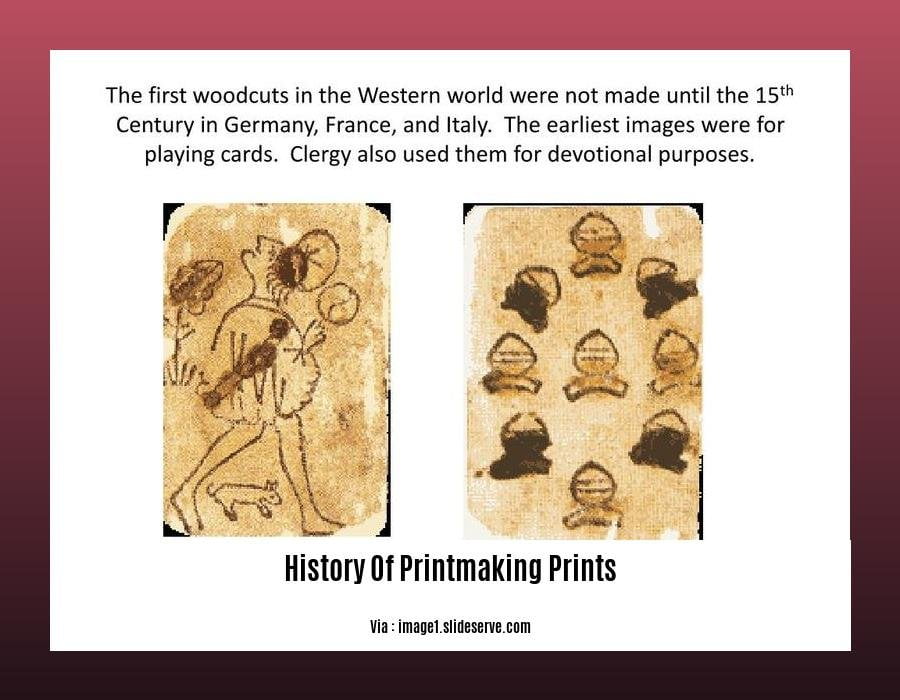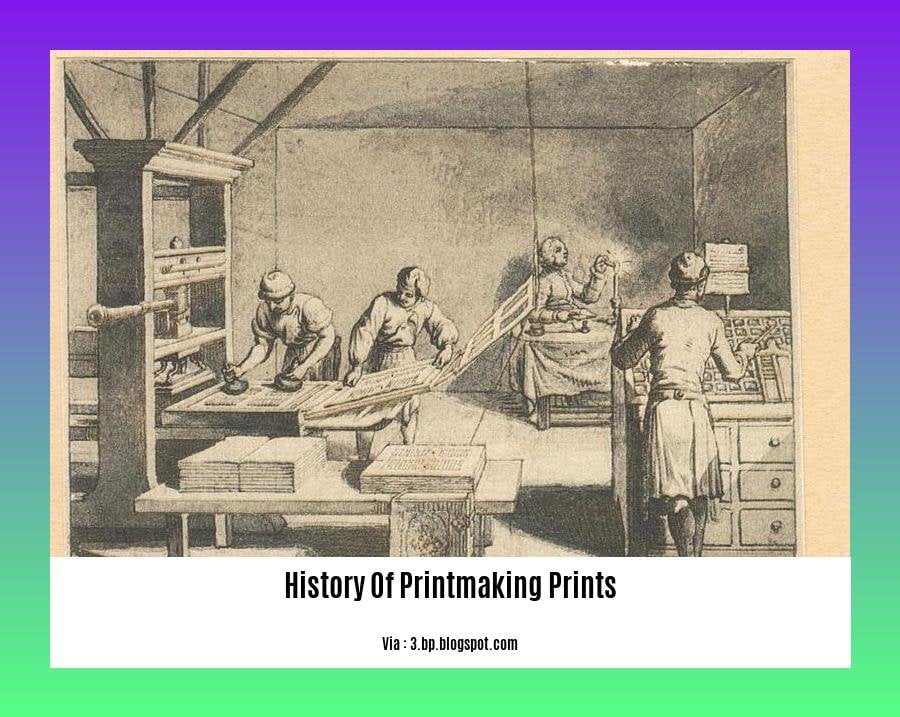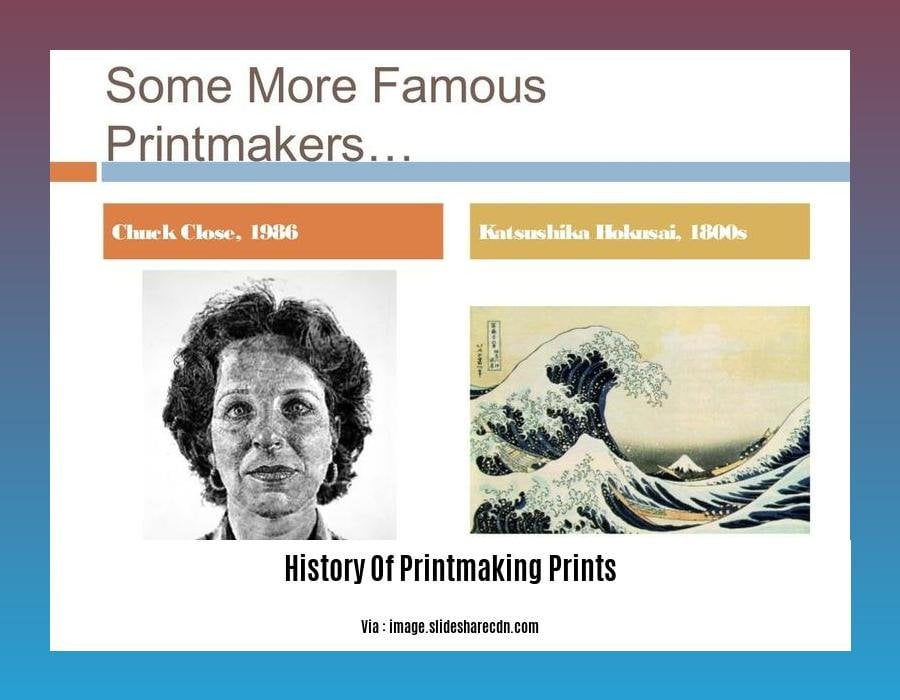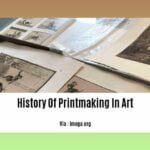Embark on [- A Journey Through the History of Printmaking Prints: Exploring the Evolution of an Art Form] as we delve into the captivating world of printmaking, tracing its remarkable journey from ancient origins to contemporary expressions. Discover the techniques, innovations, and artistic brilliance that have shaped this enduring art form, leaving an indelible mark on the annals of art history.
Key Takeaways:
Printing has witnessed remarkable transformations, starting with moveable type in 1041, Gutenberg’s groundbreaking press in 1440, and progressing to etching, lithography, offset printing, screen printing, inkjet printing, and more.
The invention of printing profoundly impacted society by spreading knowledge, ideas, and information, fueling advancements in education, communication, and cultural exchange.
History of Printmaking Prints: Evolution of an Art Form

From ancient woodcuts to contemporary screen prints, the history of printmaking prints is a fascinating journey through artistic innovation. Let’s delve into this rich art form’s evolution, exploring the techniques, artists, and cultural influences that have shaped its unique identity.
Early Origins of Printmaking
The earliest forms of printmaking can be traced back to ancient civilizations, where artisans used woodblocks to create decorative patterns on textiles and paper. As civilizations advanced, printmaking evolved into a sophisticated art form, with the development of techniques like engraving, etching, lithography, and silkscreen printing.
Techniques of Printmaking
Xylography (Woodblock Printing): In this ancient technique, artists carve designs onto a wooden block, which is then inked and pressed onto a surface.
Engraving: Here, artists use sharp tools to carve designs into a metal plate, which is then inked and printed.
Etching: A metal plate is coated with a waxy ground, and designs are scratched into the wax. The plate is then dipped in acid, which etches the exposed metal, creating the print.
Lithography: This technique involves creating an image on a flat stone surface, which is then inked and printed.
Silkscreen Printing: Artists use a stencil to transfer ink onto a surface, creating bold and vibrant prints.
Evolution of Techniques
Over the centuries, printmaking techniques have undergone continuous development and refinement. The invention of the printing press in the 15th century revolutionized the art form, enabling mass production of prints. Advances in technology, such as the development of new inks, papers, and printing presses, further expanded the possibilities of printmaking.
Notable Artists and Movements
Numerous renowned artists have made significant contributions to the history of printmaking prints. Albrecht Dürer’s intricate engravings captured the essence of the Renaissance period, while Rembrandt van Rijn’s innovative use of light and shadow transformed printmaking into a fine art. In the modern era, artists like Pablo Picasso, Andy Warhol, and Robert Rauschenberg pushed the boundaries of the medium with their bold and experimental techniques.
Cultural Significance
Printmaking has played a crucial role in communicating ideas, cultural narratives, and artistic expressions. It has been used for everything from religious imagery to political satire, from advertising to fine art. The mass production of prints facilitated the widespread dissemination of knowledge and artistic appreciation, contributing to the development of a global art culture.
Contemporary Printmaking
In recent decades, printmaking has continued to evolve, embracing digital technologies and new artistic approaches. The use of digital software and printers has opened up new avenues for artistic expression, allowing artists to create innovative and unique prints. Printmaking has also become an integral part of contemporary art practices, with artists exploring its potential for installation, performance, and social commentary.
Conclusion
The history of printmaking prints is a captivating tale of artistic ingenuity, experimentation, and cultural significance. Through the evolution of techniques, the contributions of influential artists, and its impact on society, printmaking has proven to be a resilient and dynamic art form that continues to inspire and intrigue audiences worldwide.
Learn the fascinating tale of printmaking’s origins and evolution through time by clicking on When Did Printmaking Originate. Discover the intricacies and value of prints by exploring the question, Are Prints Of Paintings Worth Anything. Immerse yourself in the world of original prints and their significance by uncovering the answer to, Are Original Prints Valuable. Embark on a journey through the History Of Printmaking In Art, tracing its profound impact on society and culture. Finally, delve into the intriguing question, Why Is Printmaking Important In Our Society, exploring its enduring relevance and diverse applications.
History Of Printmaking Prints In The World

Printmaking has been in the spotlight for several centuries, encouraging artistic expression in many forms. Let’s explore the timeline of its evolution.
The Roots of Printmaking:
Printmaking traces its roots back to the earliest civilizations, where cave paintings and seals left their mark. As time passed, China, the artistic hub, introduced the concept of duplicate artwork using stones and seals.
The European Flourishing:
The 15th century witnessed the flourishing of printmaking in Netherlands and Burgundy. They made use of woodcuts, especially in book illustrations by masters of their time. Simultaneously, in 16th-century France, book illustrations were on the rise, capturing historical and religious themes.
The 19th Century Revolution:
A significant shift came in the 19th century when lithography graced the scene. This innovation brought forth new possibilities, making artists venture beyond traditional techniques. This period saw printmaking as a medium for political and social commentary.
Diverse Techniques at Play:
Printmaking envelops a myriad of techniques. Each one exhibits unique artistic effects:
– Woodcut: Image carved on wood, transferring the design.
– Engraving: Metal plates incised with sharp tools.
– Etching: Creating etched images on metal plates.
– Lithography: Using slabs of limestone.
– Screen Printing: Stencil method transferring ink to paper.
Masterpieces and Notable Artists:
The printmaking world boasts many masters who shaped its course:
- The enigmatic Albrecht Dürer’s intricate woodcuts.
- Rembrandt van Rijn’s profound etchings.
- Francisco Goya’s evocative lithographs.
- Edvard Munch’s poignant woodcuts.
Impact on Society:
Printmaking’s influence is profound. It has:
– Facilitated the spread of knowledge and ideas.
– Inspired artistic movements.
– Enhanced appreciation for aesthetics.
– Preserved cultural heritage.
Key Takeaways:
- Printmaking has a long and rich history, evolving from ancient origins to diverse modern techniques.
- Diverse Techniques: Woodcut, engraving, etching, lithography, and screen printing are among the most prominent methods.
- Notable Artists: Albrecht Dürer, Rembrandt, Francisco Goya, and Edvard Munch are a few legends in the printmaking realm.
- Social Impact: Printmaking influenced society by spreading knowledge, inspiring artistic movements, elevating aesthetics, and preserving cultural heritage.
Sources:
Printmaking – Britannica
History of Printmaking: A Look at the History of Creating Art in Multiples
History of Printmaking Prints Wikipedia
Printmaking prints, an art form with a rich history and cultural significance, have showcased human creativity for centuries. From ancient origins to contemporary innovations, this article takes a journey through the evolution of printmaking prints, exploring the techniques, artists, and movements that have shaped this captivating art form.
Key Takeaways:
- Printmaking involves creating artworks by printing on surfaces like paper.
- Techniques include relief, intaglio, planographic, and stencil.
- Woodblock printing, a Chinese innovation, was initially used for textiles and later expanded to paper.
- Printmaking encompasses various coloring techniques for adding color to prints.
- Protective gear is crucial for safety when engaged in etching and lithography.
Early Beginnings:
The roots of printmaking prints can be traced back to ancient civilizations, with early examples found in China around the 5th century. These early prints were primarily used for decorative purposes on textiles and gradually evolved into a medium for artistic expression.
Woodblock Printing and Beyond:
Woodblock printing, a fundamental printmaking technique, originated in China and later spread to Japan and Europe. This technique involves carving a design onto a wooden block and printing it onto paper using ink. Renowned artists such as Albrecht Dürer and Katsushika Hokusai utilized woodblock printing to create iconic artworks.
Intaglio and Lithography:
The 15th century witnessed the emergence of intaglio techniques like engraving and etching. These techniques involve creating incised lines or textures on a metal plate, which is then inked and printed. Artists like Rembrandt and Goya employed intaglio techniques to produce masterful prints.
Lithography, a relatively modern technique, emerged in the 19th century. It involves creating an image on a flat limestone surface using an oil-based crayon. The limestone is then inked and printed, with water repelling the ink in non-image areas. Édouard Manet and Henri de Toulouse-Lautrec were notable exponents of lithography.
Screen Printing and Contemporary Techniques:
Screen printing, a stencil-based technique, gained popularity in the 20th century. Artists like Andy Warhol employed screen printing to create vibrant and iconic artworks.
Contemporary printmaking techniques include digital printmaking and 3D printing, pushing the boundaries of this art form further.
Preserving Prints for Posterity:
Preserving printmaking prints is crucial to ensure their longevity. Proper storage, handling, and framing techniques can help protect prints from fading, moisture, and other damaging factors.
The Impact of Printmaking:
Printmaking prints have had a profound impact on the art world, facilitating the dissemination of ideas and artistic styles. Printmaking prints have also played a significant role in social and political movements, serving as powerful tools for communication and expression.
Conclusion:
Printmaking prints have witnessed a remarkable evolution throughout history, with various techniques, artists, and movements contributing to its rich tapestry. From ancient origins to contemporary innovations, this vibrant art form continues to inspire and captivate audiences worldwide.
Sources:
Wikipedia: Printmaking
Woodblock Printing – Wikipedia
FAQ
Q1: When did the evolution of printmaking begin?
A1: The evolution of printmaking can be traced back to prehistoric times, with evidence of early engraving techniques found on bones, stones, and cave walls. However, the significant developments in printmaking emerged during the 15th century in the Netherlands and Burgundy, where woodcut book illustrations played a crucial role in popularizing the art form.
Q2: How did printmaking impact society?
A2: The invention of printing using movable type and the subsequent development of printmaking techniques had a profound impact on society. It facilitated the dissemination of knowledge, ideas, and information, leading to advancements in education, communication, and cultural exchange.
Q3: What are the key techniques used in printmaking?
A3: Printmaking encompasses a wide range of techniques, each producing unique artistic effects. Some of the most prominent methods include woodcut, engraving, etching, lithography, and screen printing. These techniques involve transferring an image from a matrix onto paper or other surfaces, allowing for multiple impressions of the same design.
Q4: Which notable artists have contributed to the history of printmaking?
A4: Throughout history, numerous artists have made significant contributions to the evolution of printmaking. Notable printmakers include Albrecht Dürer, Rembrandt, Francisco Goya, and Edvard Munch, whose iconic works continue to captivate audiences and influence the art form’s development.
Q5: How has printmaking evolved over time?
A5: Printmaking has undergone significant evolution over time, adapting to changing technologies and artistic styles. From early engraving techniques to the invention of lithography and the rise of contemporary printmaking methods, the art form has continuously expanded its possibilities for artistic expression and communication.
- Green Natural Sandstone: Eco-Friendly Building Solutions - April 19, 2025
- Red Cross Flag: Protecting Humanity Through History - April 19, 2025
- China II Review: Delicious Food & Speedy Service - April 17, 2025
















